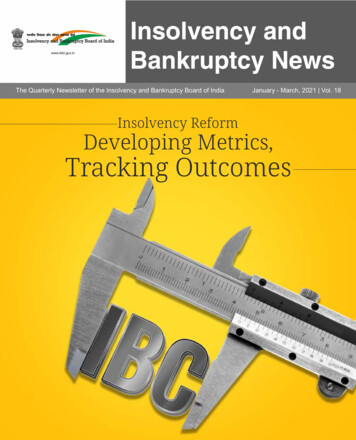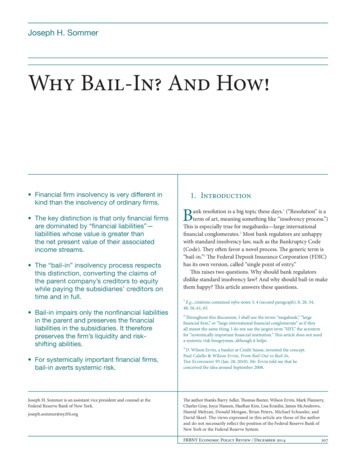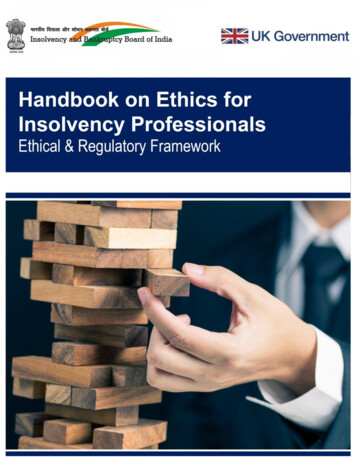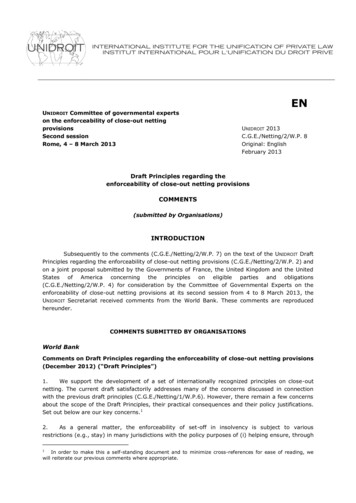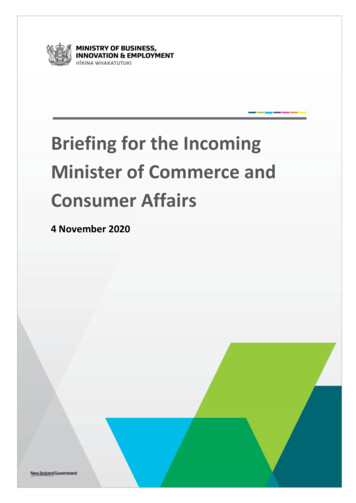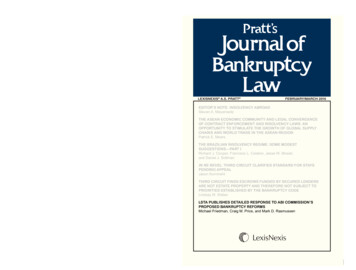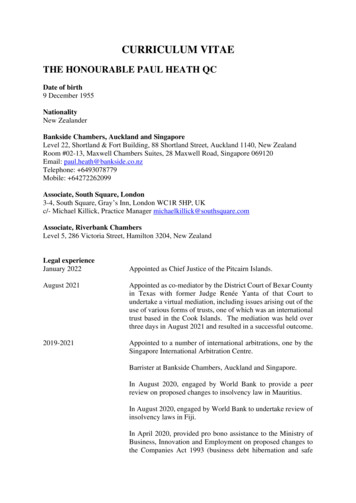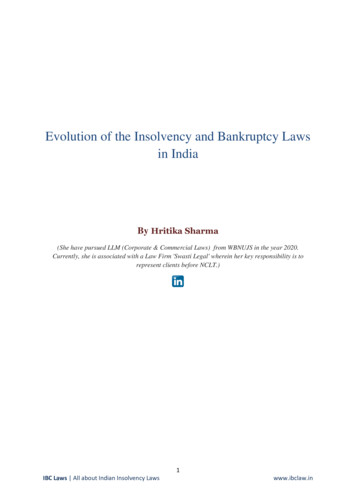
Transcription
Evolution of the Insolvency and Bankruptcy Lawsin IndiaBy Hritika Sharma(She have pursued LLM (Corporate & Commercial Laws) from WBNUJS in the year 2020.Currently, she is associated with a Law Firm 'Swasti Legal' wherein her key responsibility is torepresent clients before NCLT.)1IBC Laws All about Indian Insolvency Lawswww.ibclaw.in
List of AbbreviationSL NO.ABBREVIATIONFULL FORM1.BLRCBankruptcy Law Reforms Committee2.DRTDebts Recovery Tribunal3.DRATDebts Recovery Appellate Tribunal4.IRPInsolvency Resolution Process5.NCLTNational Company Law Tribunal6.NCLATNational Company Appellate Tribunal7.OCOperational Creditor8.RDDBFIRecovery of Debts Due to Banks and9.SARFAESISecuritisation and Reconstruction of FinancialAssets and Enforcement of Securities Interest2IBC Laws All about Indian Insolvency Lawswww.ibclaw.in
TABLE OF CONTENTSChapterNo.Chapter NamePage No.List of Abbreviation2Table of Contents3Chapter 1Introduction4-6Chapter 2Need for Bankruptcy Laws in India6-8Chapter 3The Evolution of Bankruptcy Laws in India8-9Chapter 4The Principle Legislation for Corporate Insolvency9-10Chapter 5Progression of Insolvency and Bankruptcy Code, 201610-17Chapter 6Conclusion and Suggestions17BibliographyContentsList of Abbreviation . 2TABLE OF CONTENTS. 3INTRODUCTION: . 5SCOPE OF STUDY: . 5OBJECTIVES: . 5RESEARCH METHODOLOGY: . 5SCHEME OF CHAPTERISATION: . 6CHAPTER 1: INTRODUCTION . 6CHAPTER 2: NEED FOR BANKRUPTCY LAWS IN INDIA . 63IBC Laws All about Indian Insolvency Lawswww.ibclaw.in
CHAPTER 3: EVOLUTION OF INSOLVENCY AND BANKRUPTCY LAWS IN INDIA . 6CHAPTER 4: The PRINCIPLE LEGISLATION FOR CORPORATE INSOLVENCY . 7CHAPTER 5: PROGRESSION OF INSOLVENCY AND BANKRUPTCY CODE, 2016 . 7CHAPTER 6: CONCLUSION AND SUGGESTIONS . 7NEED FOR BANKRUPTCY LAWS IN INDIA . 8THE EVOLUTION OF BANKRUPTCY LAWS IN INDIA . 10Indian Insolvency Act, 1848 . 10Administration towns Insolvency Act, 1909 . 10THE PRINCIPLE LEGISLATION FOR CORPORATE INSOLVENCY . 12PROGRESSION OF INSOLVENCY AND BANKRUPTCY CODE, 2016 . 13The Bankruptcy Law Reforms Committee Report . 13The significant commendations of the report are in the following way: . 14Financial and Operational creditors’ difference: . 14Uniform Legislation . 14Trigger . 15Supervision of the entity in the course of IRP: . 15Moratorium. 15Creditor Committee: . 16Time bound Insolvency Resolutions: . 16No restrictions on solutions to resolve the Insolvency: . 16Time-Bound Liquidation with Defined Pay-out Prioritization. 17CHAPTER 6: CONCLUSIONS AND SUGGESTIONS. 19BIBLIOGRAPHY . 20d.https://ibbi.gov.in/BLRCReportVol1 04112015.pdf. 21e.https://drt.gov.in . 21f.https://en.wikipedia.org/wiki/National Company Law Tribunal . 21g.https://en.wikipedia.org/wiki/National Company Law Appellate Tribunal . 214IBC Laws All about Indian Insolvency Lawswww.ibclaw.in
INTRODUCTION:When a person, company, association or any other institution do not fulfil its money relatedobligation it is known as Insolvency, it is basically a state of being not able to pay the moneyborrowed by an individual or company within a specified time on the other hand theexpression bankruptcy is nothing but a ground which makes a company or an organisationcapable to file a petition in the court of law in the situation when it fails to fulfil any financialobligation or repay the owed amount to the creditors. The petition is supposed to be lodged inthe court where each and every outstanding debts of an organisation are valued and cashedout. Bankruptcy lodging is a lawful approach carried out by an organisation to free itself fromany financial or debt obligation. Debts which are basically not fully paid to the lenders andcreditors. However the procedure to be followed in the event of filing a petition forbankruptcy varies in different countries for instance in India if an individual files a petitionfor bankruptcy, it will not be good for his credit rating as the filing of bankruptcy will make itvery hard for a company to get a fresh loan from any creditor. It can occur due to event ofspecific things such as substandard money administration, increment in original money costs,or depletion in cash flow and the list goes on. There was a time when India spotted theindustries are being surrounded by rampant industrial illness which gave rise to the situationswhere creditors remained unpaid which was certainly influencing the interest of creditors andlenders as they did not have any instrument to recover their money, this is when it has beenrealized that there is a need of an enactment which will regulate the expressions such asinsolvency and bankruptcy. Consequently huge efforts made to set up a framework in orderto deal with the same.SCOPE OF STUDY:The chapter pays special attention on knowing by what means Indian legislation andregulation with concern to the insolvency resulted in the development of insolvency andbankruptcy Code 2016, by examining the existing legislation came into existence for thepurpose to regulate the acts arising out of liquidation.OBJECTIVES:The principle goal of this research is to find out how Indian legislation with concern to theinsolvency caused to the evolvement of insolvency and bankruptcy laws in India.RESEARCH METHODOLOGY:The methodology followed in this research will be purely doctrinal in nature. This research ison the “evolution and origin of insolvency and bankruptcy in India”. Therefore the researcherwill be dealing mainly with the doctrinal material available. Since various doctrinal resourcesare very easily available on this particular topic, thus the researcher has contracted mainly onsuch resources and has dealt in all such resources in a comparative manner and analyticalnature.The researcher will be taking help of various primary sources 1 such as text of the CompanyAct,1956 Company Act 2013, Sick Industrial Companies Act, 1985( SICA), Securitisation1Bare acts5IBC Laws All about Indian Insolvency Lawswww.ibclaw.in
and Reconstruction of Financial Assets and Enforcement of Security Interest (SARFAESI),Insolvency and Bankruptcy Code (IBC),The Insolvency and Bankruptcy Board of India(Insolvency Professional Agencies) Regulations 2016, The Insolvency and Bankruptcy Boardof India (Model Bye-Laws and Governing Board of Insolvency Professional Agencies)Regulations 2016, The Insolvency and Bankruptcy Board of India (Insolvency Professionals)Regulations 2016, The Insolvency and Bankruptcy (Application to Adjudicating Authority)Rules 2016, The Insolvency and Bankruptcy Board of India (Insolvency Resolution Processfor Corporate Persons) Regulations,2016 and Bankruptcy Law Reforms Committee. Thesecondary sources that the researcher will use are the various books, cases, journals, articlesand papers relating to this topic. The researcher will be making extensive use of both suchprimary and secondary sources in this researchSCHEME OF CHAPTERISATION:The Research Paper has been categorised into six chapters, which are as follows:CHAPTER 1: INTRODUCTIONThis chapter basically focuses on introducing the topic by answering what is Insolvency andBankruptcy Code, why it came into existence and more on. Along with that this chapter alsotalks about the objective of study, scope of study, hypothesis and research methodology.CHAPTER 2: NEED FOR BANKRUPTCY LAWS IN INDIAWe all know that Law ensures the protection of our rights. To conduct any act appropriatelywe need Law further an individual cannot live in society without Law as it overseeseverything it punishes every wrongful act so in consideration with that this chapter aims tomake things easier to understand that why there is a need of legislation to regulate bankruptcyand insolvency.CHAPTER 3: EVOLUTION OF INSOLVENCY AND BANKRUPTCYLAWS IN INDIAAs the name says “evolution” this chapter will discuss about how expressions like insolvencyand bankruptcy gained popularity in the business field. What is the significance of it? Thesame chapter will make the reader aware of the present status of Insolvency and BankruptcyCode.6IBC Laws All about Indian Insolvency Lawswww.ibclaw.in
CHAPTER 4: The PRINCIPLE LEGISLATION FOR CORPORATEINSOLVENCYAgain this chapter examines the principle legislation for corporate insolvency and how itplays significant role in protecting the rights of a creditor by laying down procedure to befollowed in the event of liquidation. It also talks about the placement of “Insolvency andBankruptcy” in the concurrent list mention under Schedule 7 of Indian Constitution.CHAPTER 5: PROGRESSION OF INSOLVENCY AND BANKRUPTCYCODE, 2016The main objective of this chapter is to inspect about the factors which caused theprogression of Insolvency and Bankruptcy Code 2016. It also pays attention to the report of“Bankruptcy Law Reforms Committee” and its significance. Furthermore this chapter statesabout the role Insolvency “Adjudicating Authority” in resolving the issues concerning thesame, bankruptcy and insolvency.CHAPTER 6: CONCLUSION AND SUGGESTIONSThe last chapter aims to provide suggestions regarding protection of rights for both thecreditor and the borrower along with it gives an idea and a way forward also.7IBC Laws All about Indian Insolvency Lawswww.ibclaw.in
NEED FOR BANKRUPTCY LAWS IN INDIAThe Crucial focus of existing bankruptcy enactment and finance obligation reconstructingacts is by no means the liquidation and discontinuance of matter of insolvency but somewhaton the renewal of the substances concerning capital and gradable construction of accountpossessors confronting issues concerning money for the purpose of allowing the restorationand business of themselves. There are other parts as well, where it is a crime in context to thebankruptcy laws for a business to move forward in the world of business whilst blotted out.To regulate any activity we depend on law, the aim of any legislation is to balance thingswhich are good for society and a decent society needs laws so that an individual’s rightremains protected. For instance if we talk about traffic laws, what will happen if there isno traffic laws isn’t there will be chaos everywhere. Yes there will be, thus we understandthat nothing could remain regulated unless and until a mechanism regulates it and for us thatmechanism is so called legislation. The same goes for bankruptcy and insolvency also,any new age company would require capital to flourish thus it will take loan, it iscompelled to borrow money but in the event it defaults to fulfil its obligation owed tocreditors then creditors will start losing the interest to lend money so basically there isneed to protect the interest of lender so that the process of borrowing and lending willbe continue which even helps the country to grow the economy so we understand thateverything is interlinked with each other and virtually benefitting us, this is why it becomesvery important to ensure that this remains active and that the interest of a creditor remainsprotected thus the legislation related to indebtness was needed.The legislation for indebtness is nothing but a cordial statute which has been set in motion toprovide interval as well as assuagement to the equitable account possessors who for thereason any kind of serious or unexpected requirement end up clearly incompetent forrepayment of their commitments.2Its query is in addition of guaranteeing dissemination of an indebted person’s sphere amongsthis creditors in an impartial manner and on the basis of that point to dismiss him pursuant toparticular circumstances from taking a chance concerning to his commitments.If we look into the Act of bankruptcy we find that it has been certainly ignored. In the eventthat a person is declared insolvent, he is not viewed as trustworthy. Despite whatever hasbeen said the statute of bankruptcy safeguards the account holder from the embarrassment,humiliation and abuse of his creditors.In a case when a person is pronounced bankrupt, his creditors are exiled from filing any suitor legal procedures in counter to him as well as they cannot even look for any remedy againsthis assets related to their commitments supportable under the law of indebtness. Onarbitration of a debtor as destroyed his whole assets entrust to official collector. His banks areanxious on the betterment of their commitments than confronting the individuals beingindebted. Consequently after vesting interest of assets in official beneficiary, it is c/Insolvency-and-Bankruptcy-Code-20168IBC Laws All about Indian Insolvency Lawswww.ibclaw.in
that they are disburdening of being deceived by the one indebted person or of the concern ofthe account possessor taking away his assets.3 The indebted, in case any circumstance fliesfar away from the location of the Insolvency Court, it not in any way disturbs them as theauthentic consignee being the person in whom the property of the bankrupt entrusted. On thetop of that their commitments are to be recognized on the basis of returns collected byrecipients in the formal discharge of his abilities within the Insolvency law.Speaking about the way about liquidation of an association is regulated according toCompanies Act and is under the auspices of the court. But as per the Article 19 (1)(g) of theConstitution of India it says about the ability to exercise whatsoever profession or to keep onany occupation, trade or business to the every inhabitants of India, there are restrictions oncompletion of any contemporary endeavour. Aforementioned constraint is protected on thebasis that it is in extensive dawn eagerness to anticipate the state of being unemployed. Inview of fact that such strategy there is a possibility to seek any liberal action, neverthelessthere is no elasticity to exit.3IBC an on-going process9IBC Laws All about Indian Insolvency Lawswww.ibclaw.in
THE EVOLUTION OF BANKRUPTCY LAWS IN INDIAIn the Presidency – towns the foremost Insolvency court were put in place by means ofstatute 9 Geo.4,c. 73, go in the year 18284. Basically those were the courts established to helpthe Insolvent Debtors. They were individual courts as well as courts of records. Any persondisturbed because of the choice of the abovementioned court can move or proceed to theSupreme Court which is to be regarded as above all. The Supreme Court organized thecapacity to hear the collection and transfer such kind of requests as it distinguished fair andconsiderable and identical application or demand is to be deferred through the courts for themitigation of insolvent or the borrower. The workers of the court of insolvency wereentrusted by the Supreme Court. One of such official was regarded as “normal appointee”. Inthe event that an appeal for mediation was initiated or originated by one lender as well anorder for arbitration was created the property interest of the indebted entrusted in the simpleselected one by uprightness of the request. Agreement was in further made for the breakguarantee orders.Indian Insolvency Act, 1848It was the year 1848 when the past approvals were revoked and other Act was adopted socalled the Indian Insolvency Act, being 11 and 12 Vict. c. 21.5 The Act stored the provisionsamong all merchants and non-brokers make specific reference6. Through this Act the Courtsonly for the alleviation of Insolvent Debtors established by the Act of 1828 were supposed tobe moved however the Court was to take place within the persistent watch of judges ofSupreme Court.Administration towns Insolvency Act, 1909In advance of agenda in the twentieth century it was believed that the Indian Insolvency Act,1848 has proven out to be antiquated and it was elected or we can say nominated tocreate separate law based on English Bankruptcy Acts. Same Act i.e. The Act of 1848was to be believed as having no value or so called annulled and consequently a differentseparate Act was approved in 1909 being the Presidency-towns Insolvency Act7 takinginto account of the Bankruptcy demonstration 1883 and the Bankruptcy Act 1890. Aseverything has a flaw likewise the Indian Insolvency Act also has its own flaws, one of themain and solid defaults was that the Act was rather benefitting the borrowers to greaterextent but not lenders. The troops of legal assignee were exceedingly restrained. He justbrought assets together and had no strength to consider the measures. By means of new Actenormous strength was provided rather given to the courts to push the disclosure of theindebted property. Section 79 speaks and requires the official trustee to investigate or inspectthe case of bankruptcy and provide an answer or respond to the court upon whatsoeverapplication for liberating stating whether there is encouragement to trust that the wiped out4Evolution of Insolvency and Bankruptcy Code 2016Some Emerging Trends In The Evolution of Insolvency And Bankruptcy Code6Insolvency and Bankruptcy Code (IBC)7Insolvency and Bankruptcy Practice Manual510IBC Laws All about Indian Insolvency Lawswww.ibclaw.in
had granted any indebtedness crimes or certain other crimes mentioned under segment 421 to424 of the Indian Penal Code8 with concern to his indebtedness or which would justify thecourt in cannot, interrupting or limiting a request for his release.8Administration towns insolvency Act,190911IBC Laws All about Indian Insolvency Lawswww.ibclaw.in
THE PRINCIPLE LEGISLATION FOR CORPORATE INSOLVENCYThe Indian Constitution set up in 1950 provides listed the expressions such as “Insolvency”and “Bankruptcy” in the third list of schedule 7 i.e. concurrent List. On the other hand, theterms such as incorporation, command and liquidation of enterprises are mentioned under theUnion List.With these strengths or we can say strong points provided in the Constitution, CompaniesAct, 1956 came into the existence which gave a new shape to corporate field. In fact thisAct contained virtually all provisions concerned or related to the workings of companiesalong with the process of winding up. And it is believed that it even decreased the fraudulentactivities. But the main point to be noted is the despite the Act was a good initiative by thegovernment but the other fact which attempts to say that this Act never made any sensewith regard to expressions like insolvency or bankruptcy and has no power to deal withpayment of debts notwithstanding that this Act was chief law for the purpose ofadjusting corporate bankruptcy. The Companies Act, 1956 included particular measuresby which the association or its lenders could try to restructure it. However, these wereparticular regulations and not specific to bankruptcy or insolvency conditions.It is noteworthy and important to know that in the year two thousand thirteen, there wereapproximately 13.5 lakh enrolled organisations in our country India of which only 9.4 lakhwere active. Strangely enough on a regular note in the proximity of 2008 and 2010, not morethan 6,455 cases of twisting up were enlisted with the High Courts. Just near two hundred tothree hundred cases were incorporated each and every year and above that approximatelythree hundred to six hundred fifty completed each year. These characteristics or we can sayindicators showed that the less application of the Companies Act approaches for handlingcorporate indebtedness. Furthermore it demonstrates a deficiency of limit at the courts to dealwith such case volumes. Occasional evidence suggests or rather prefers that winding up orliquidation under the said Act, generally, requires nearly five to seven years getting end aswell as in exorbitant cases evening twenty six to thirty one years.However there was a time when innumerable changes concerned with the insolvency relatedmeasures mentioned under Companies Act, 1956 was proposed by the Act so called “TheCompanies (Amendment) Act, 2003”. Be that as it may these couldn’t be successful sincelegitimate challenges.Following this in the year 2013 the new Companies Act was approved. And a significantproportion of the measures of the 2013 Act were in conformity with those planned under thelast amendment which occurred in the year 2002. Implementation issues concerning to thecorporate insolvency measures moved equal with the new Companies Act, 2013.12IBC Laws All about Indian Insolvency Lawswww.ibclaw.in
PROGRESSION OF INSOLVENCY AND BANKRUPTCY CODE, 2016The Bankruptcy Law Reforms Committee ReportIn 2014, an essential struggle at far sighted bankruptcy amendment was cherished when theMinistry of Finance established by the by the Bankruptcy Law Reforms Committee(BLRC) under the Chairmanship of Dr. T. K Viswanathan9. The order of the BLRC was tospecify an Indian Bankruptcy Code that supposed to be relevant to entire non- financialassociated corporations and people as an individual, and would supersede the presentsystem. The aforementioned committee submitted its report and a deep seated proposalInsolvency and Bankruptcy Code (IBC) to the administration in November 2015.The Committee put forward its report on December 4, 2015 which is believed to be dividedinto two sections comprises of “volume one” and “volume two”. Volume – 1 of the reportlays down the base and structure on the other hand Volume – 2 of report certainly talkedabout the absolute draft of the Insolvency and Bankruptcy Code, coating the wholematter. The technique of Insolvency settlement and winding up under the code isasseverated on the escorting institutional foundation.A comptroller especially, the Insolvency and Bankruptcy Board of India10(Regulator);II.A structure of directed insolvency professionals and controlled data utilitiesIII.The adjudicating management, in particular the National Company Law Tribunalwhich governs corporate components as well as the Debt Recovery Tribunals whichsupervises number of people.As a consequence, the Code suggests for the coverage of the full gamut of entities, not justonly corporate entities along with limited liability partnerships, but on top of that individualsalso, and stipulates procedures for handling with issues concerned to bankruptcy for everyaforementioned entity.I.The Code intends substituting the existing corporate insolvency regulations through a singlewidespread law that 9authorizes entire lenders (whether secured, unsecured, domestic, international,financial or operational) to activate determination procedures;makes it possible that the procedures of resolution to begin at the earliest as possibleas a sign of financial hardship ;permits for a sole platform to monitor whole insolvency and liquidation procedures;allows a soothe duration wherein fresh prosecution do not dissuade current ones;lays down for substituting present administration throughout insolvency processeswhile balancing the undertaking in the normal operation;The Bankruptcy Law Reforms Committee Report10https://ibc.taxmann.com/13IBC Laws All about Indian Insolvency Lawswww.ibclaw.in
provides a bounded time limit during the time the debtor’s practicability can beevaluated: andSets out a lineal liquidation instrument.The significant commendations of the report are in the following way:Financial and Operational creditors’ difference:The Code speaks about a difference between financial lenders (both ensured and unsecured,who have expanded loan for interest, as distinguished from in interchange for the provisionsof goods and services). This distinction have been achieved for the purpose to address one and the other, secured and unsecured creditors, at face value with theobject to create an IRP and offer an opportunity or chance to take part in the policymaking procedures; Empower a functional lender to activate an IRP, but will not be involved in themaking of a decision because aforementioned creditor is paid for the liquidationprocess, they cannot participate in the decision making process becauseaforementioned creditors would be paid the winding up value at the very least.The Code makes difference between financial creditors (both secured and unsecuredlenders, who have expanded accredit for interest) on the other hand functional lenders(who have expanded credit in place of goods and services). The dissimilarity is designedat the management of the secured and unsecured lenders both on same conditions with theobject to initiate an IRP and supplying an window of luck to be involved in the resolutionmaking procedures; functional lender is capable to activate an IRP, becauseaforementioned functional creditor is remunerated for the winding up procedures, theycannot engage in the procedures of making resolutions.Uniform LegislationThe code stipulates for a uniform law. Each and every previous legislations, enactmentsconcerning with insolvency and bankruptcy those are spread are to be carried withinthe frame of single legislation. It abrogated couple of laws as well as modified half ofdozen regulations handling the expressions insolvency and bankruptcy. The PresidencyTowns Insolvency act, 1909 as well as the Provincial Insolvency Act, 1920 gotabrogated11. Companies Act, 2013, Sick Industrial Companies (Special Provisions)Repeal Act, 2013, limited Liability Partnership Act, 2008, SARFAESI Act, 2002,RDDBFI Act, 1993 and Indian Partnership Act, 1932 was modified following the passingof the code12.1112Some Emerging Trends In The Evolution of Insolvency And Bankruptcy CodeBare acts14IBC Laws All about Indian Insolvency Lawswww.ibclaw.in
TriggerThe primary and main objective of the Code is to capture the suffering as well as settle itat the earliest possible date and along with that it basically aimed to balance the chaosbetween the lender and borrower by resolving the issue. To accomplish the same, itprovides an opportunity to the IRP to be launched on the occurrence of a uniqueinfringement. However the procedure is slightly diverse for all the borrowers or we can saydebtors, financial lenders and functional creditors which are explained below.Financial creditors upon the occurrence of the payment default for amounts indebted to themor any all of the other commercial lender can lodge a request cum application in front ofNCLT in order to activate the IRP. For an operational borrower cause spark in IRP, anannouncement by the Operational Creditor to the borrower on the event of the non-paymentis needed or required. Following this kind or type of updates, notification the borrower isimperative to whether reimburse or provide rationale because of the subsistence for anauthentic dispute. Within specified time of ten working days if the defaulter omits to do suchcondition from the notification which has been published, further the OC is authorized tolodge a complaint before the appropriate authority i.e. NCLT for the purpose and in order toinitiate the IRP. Borrower like shareholders (an individual or an organisation who owns atminimum one share of a company’s stock), administrati
Bankruptcy" in the concurrent list mention under Schedule 7 of Indian Constitution. CHAPTER 5: PROGRESSION OF INSOLVENCY AND BANKRUPTCY CODE, 2016 The main objective of this chapter is to inspect about the factors which caused the progression of Insolvency and Bankruptcy Code 2016. It also pays attention to the report of


